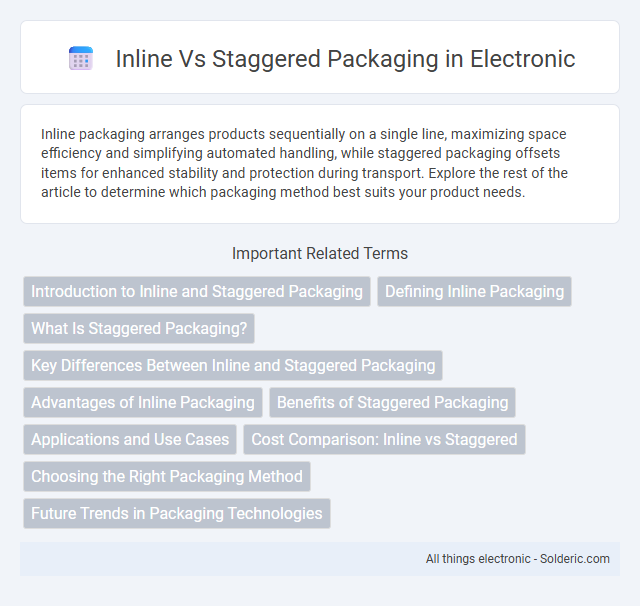Inline packaging arranges products sequentially on a single line, maximizing space efficiency and simplifying automated handling, while staggered packaging offsets items for enhanced stability and protection during transport. Explore the rest of the article to determine which packaging method best suits your product needs.
Comparison Table
| Feature | Inline Packaging | Staggered Packaging |
|---|---|---|
| Definition | Products aligned straight in a single row or column. | Products arranged in offset rows creating a staggered pattern. |
| Space Efficiency | Lower; uses uniform spacing, less compact. | Higher; staggered layout maximizes space usage. |
| Product Stability | Moderate; stable but prone to shifting in transit. | High; interlocking pattern enhances stability. |
| Packing Speed | Faster; simple alignment improves speed. | Slower; requires careful arrangement. |
| Use Case | Best for uniform, rigid products with simple shapes. | Ideal for irregular shapes or items needing extra support. |
| Cost Implications | Lower labor and equipment costs. | Higher due to complexity and time needed. |
| Common Industries | Electronics, pharmaceuticals. | Food & beverage, heavy manufacturing. |
Introduction to Inline and Staggered Packaging
Inline packaging arranges products in a straight, linear sequence for organized and efficient processing, ideal for consistent product shapes and sizes. Staggered packaging places items in an offset pattern, maximizing space utilization and providing enhanced protection against damage during transportation. Both methods optimize packaging depending on product stability, volume, and shipping requirements.
Defining Inline Packaging
Inline packaging refers to a production process where packaging machinery is arranged sequentially within a single continuous line, allowing products to move directly from one station to the next without interruption. This setup enhances efficiency by minimizing product handling and streamlining workflows, making it ideal for high-speed manufacturing environments. Inline packaging systems are commonly used in industries such as food and beverage, pharmaceuticals, and consumer goods to optimize space and reduce cycle times.
What Is Staggered Packaging?
Staggered packaging arranges products or components in an offset pattern, creating a zigzag alignment rather than a straight line. This method enhances space utilization and improves stability during transport by distributing weight more evenly. Your inventory benefits from optimized packing density and reduced damage risk with staggered packaging.
Key Differences Between Inline and Staggered Packaging
Inline packaging aligns products uniformly in a single, straight row, offering simplicity and faster processing for uniform items. Staggered packaging arranges products in offset rows, maximizing space efficiency and providing better protection by distributing pressure evenly. Your choice depends on product shape, packaging speed, and protection requirements.
Advantages of Inline Packaging
Inline packaging offers streamlined production efficiency by organizing packaging stations sequentially, reducing material handling and minimizing bottlenecks. This setup enhances real-time quality control and consistent product flow, leading to higher throughput and lower labor costs. Your manufacturing line benefits from simplified maintenance and scalability, making inline packaging ideal for high-volume, uniform product runs.
Benefits of Staggered Packaging
Staggered packaging enhances product protection by minimizing direct pressure points and distributing weight evenly, reducing damage during transit. It optimizes space utilization, allowing more efficient pallet stacking and improving storage efficiency. Your shipments benefit from increased stability and reduced risk of shifting, ensuring safer delivery and lower costs.
Applications and Use Cases
Inline packaging is ideal for high-speed production lines, frequently employed in food and beverage industries for products such as snacks, bottled drinks, and pharmaceuticals, ensuring seamless integration with existing conveyor systems. Staggered packaging suits complex or fragile items like electronics and medical devices, providing enhanced protection and flexibility in handling irregular shapes or sizes during packing. Both methods optimize operational efficiency, with inline packaging emphasizing volume throughput and staggered packaging prioritizing product safety and customization.
Cost Comparison: Inline vs Staggered
Inline packaging typically incurs lower initial setup costs due to its simpler machinery and streamlined process flow, making it cost-effective for high-volume production. Staggered packaging, while often involving higher upfront expenses due to complex equipment and slower operation speeds, can reduce material waste and improve space utilization, potentially lowering overall costs in customized or low-volume runs. Evaluating total cost of ownership requires considering production scale, product type, and packaging efficiency specific to each method.
Choosing the Right Packaging Method
Choosing the right packaging method between inline and staggered designs depends on product stability, presentation, and space efficiency requirements. Inline packaging aligns items uniformly, enhancing visual appeal and simplifying automated packing processes, ideal for products needing consistent orientation. Staggered packaging offsets items, improving cushioning and maximizing use of available space, making it suitable for fragile or irregularly shaped products.
Future Trends in Packaging Technologies
Future trends in packaging technologies emphasize sustainability, automation, and smart features, with inline packaging enabling real-time monitoring and seamless integration with production lines. Staggered packaging allows for flexible customization and improved efficiency in handling diverse product ranges using advanced robotics and AI-driven sorting. Your choice between inline and staggered packaging will significantly impact scalability and adaptability in embracing these cutting-edge innovations.
Inline vs Staggered Packaging Infographic

 solderic.com
solderic.com